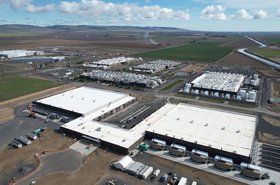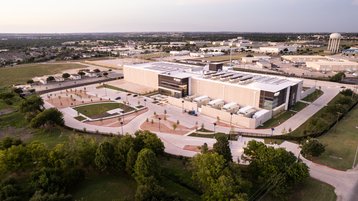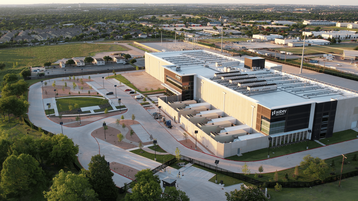Austin, Texas, may be known most commonly as the ‘Live Music Capital of the World,’ but behind the vibrant music scene lies another of the city’s defining features – its presence as a major tech hub, of course!
Straight from the source, Mark Noonan, Austin-based Senior VP, Sabey Data Centers – East (overseeing Round Rock, Texas; Ashburn, Virginia; and downtown Manhattan, New York City), shares insights with DCD on Texas’s rise as a thriving data center hotspot.
Round Rock and company
With over 20 years of experience in Texan data center operations, Noonan brings a deep understanding of the market. Three years ago, he joined Sabey’s team, who were already making strides in the region, including launching their Round Rock facility just over two years ago, officially opening it five months ago.
The 40-acre campus quickly transformed into a 250,000-square-foot, two-story facility with four data halls, dubbed Building A. Following its success, Noonan shares plans for a larger second facility, set to house 54MW of IT load, due to begin construction in February 2025.
Everything is bigger in Texas
During the conversation, Noonan emphasizes Texas as a thriving hub for data center activity, and shares plans for expansion within the state.
“Texas is a great place to do business. There are a ton of technology and technology-centric businesses here in the Austin Metro area. A lot of people refer to Austin as ‘Silicon Hills,’ so it's a really fruitful market for data centers. Historically, Austin has been a smaller market relative to large ones like Dallas, Ashburn, or Chicago, but it's growing.”
He notes that several providers have entered the Austin market since Sabey’s campus opened, with more likely to follow, and praises the local government’s support for data centers, recognizing their contributions to tax revenue and high-paying jobs.
Everybody knows data centers use a lot of power, with many veering toward renewable energy options in the hopes of running a more sustainable model and meeting their respective initiatives. Acknowledging this, Noonan highlights Sabey’s commitment to sustainability:
“We have publicly announced that we'll be completely carbon-free by 2029 on all Scope 1 and Scope 2 emissions, and leveraging Texas’s renewable energy resources will help us achieve that goal.”
Noonan also points to Texas’s affordable energy prices and robust power grid relative to the national landscape with Austin’s central position as an asset:
“There's a highly connected fiber network spanning Houston, Dallas, and San Antonio. Austin's in the nexus – in the center of all that – so there's a tremendous connectivity story.”
What lies beyond the connectivity nexus?
As the discussion unfolds, Noonan’s description of the “nexus” highlights the concentration of development in Texas’s major metros. But it poses the question: if Texas is so desirable, what’s happening beyond these tech hubs?
Noonan indicates a natural trend toward staying near major cities driven by the growing power needs in the AI age.
“Some smaller, lesser-known markets are gaining attention. A quick search for new Texas data center projects will show dozens in cities ‘outside of the main metro corridors – further away from the major metros, often in the west, where much of the renewable power is located.”
However, he points out a drawback: “Texas falls short on the sales tax side, and I believe this is something the state should address in the coming years to attract more providers to the market.”
Oklaunion: Expanding further afield
As we highlight these more rural markets, Noonan outlines one of Sabey’s upcoming developments in Oklaunion, less than 200 miles from Dallas and equidistant to Oklahoma City.
“It's literally in the midpoint of a tremendous renewable energy hub, surrounded by wind and solar farms. It's further afield, allowing us to develop a large campus with significant power capacity and enough acreage to build multiple large-scale facilities.”
The idea behind this site is that it will provide customers with lower-cost power, leveraging its renewable energy resources.
That being said, its standout feature is its specialization in accommodating a range of large-scale liquid cooling technologies, departing from traditional air-cooled designs. Noonan explains that liquid cooling has been integral to Sabey’s approach:
“In the building I’m in now, 80 percent of leased projects use liquid cooling. We’ve incorporated designs that support air-cooled, hybrid, and fully liquid-cooled systems. For example, the Texas Advanced Computing Center (TACC) will house its most recent supercomputer here, using 100 percent liquid-to-chip cooling.”
Oklaunion will adopt a similar setup, but with a liquid cooling focus from the outset, enabling smaller building footprints with higher density and capacity for high-heat load racks.
Riding off into the Texas sun
Texas has long been recognized as a strong data center market, though primarily centered around Dallas. However, as major tech hubs face power constraints driven by the growing demands of AI applications, opportunities are increasingly shifting further beyond metro areas.
“In our case, markets like Austin and San Antonio are now attracting projects that might have gone to Dallas due to those limitations,” Noonan explains. “We were very fortunate and strategic in building our campus ahead of that demand.”
It’s evident that demand will continue to fuel growth in markets like Austin and, further afield, rural areas such as Oklaunion. Noonan concludes, “I think Texas is going to be a great data center market for years to come.”
Learn more about Sabey's Austin campus here.
More on Sabey Data Centers
-

Sponsored Mission: Possible – how to thrive in a booming industry
The evolution of the data center industry, through the eyes of a US Army veteran
-

Sponsored A blueprint for rural data center growth
By thinking bigger and greener, Sabey Data Centers is bridging the gap between rural communities and cutting-edge technology, driving sustainable growth through local partnerships and renewable energy solutions
-

Sponsored Winning hearts and minds
Data centers can bring a whole lot more to communities than just great jobs, but operators must earn their trust first, as Sabey in Quincy, Washington State, demonstrates


